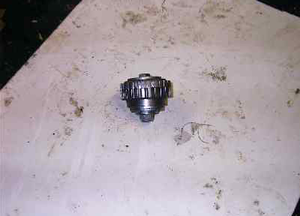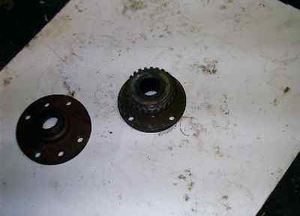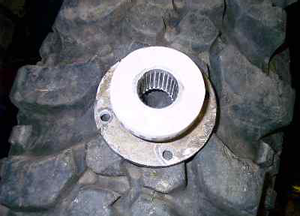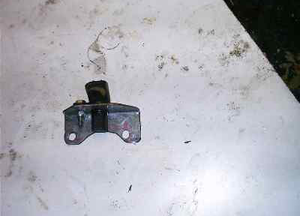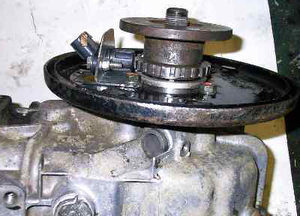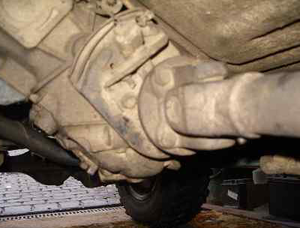![]() The content of any article might be expanded / improved in the future - revisit it sometimes.
The content of any article might be expanded / improved in the future - revisit it sometimes.
![]() Seen a mistake? Know something that isn't written? Edit and change this article yourself!
Seen a mistake? Know something that isn't written? Edit and change this article yourself!
![]() Some images in the article (if present) can be enlarged by clicking on them.
Some images in the article (if present) can be enlarged by clicking on them.
Introduction
![]() This article has been submitted by Phil Bailey.
This article has been submitted by Phil Bailey.
Many thanks to Phil for writing the article and for providing a cheap, but effective solution to the electronic speedometer conversion.
I have modified 2x SJ410 transfer boxes to take a Jimny electronic Speedo and only used a hacksaw, angle grinder, files, drill and a welder.
I have done this in two different ways.
Both ways are "el-cheapo" / "poor man's" DIY solutions.
Version 1
The 1st version was done with the same teeth size, diameter etc as the original Jimny Speedo system. I used a “spare” output flange. It was roughly ”whittled” down to the same outside diameter as the original Jimny gear using a hacksaw then an angle grinder. Next, I cut the centre out off it, to leave a flat sided disk. I did this by chain drilling, then removing the centre. Then I bolted this Blank to the original Speedo gear. Next I smoothed the outside of the blank to the exact same size as the original using a smooth flat file. (You can’t file/damage the original because it’s hardened). Then, using the hacksaw, I cut the slots between the teeth. Again using the original as a guide. I finished off the slots with a square needle file.
I unbolted the two gears. Then tack welded the gear to the rear TX box flange. There is a nice step in the flange which I butted the gear up to. This helped it to stay straight. I checked it was running true by fit ting it to the TX box and spinning it round. When happy with it I welded it more securely.
Next I used some car body filler to fill the gaps between the teeth. I also made it thicker to get it as close as possible to the TX box rear oil seal. I smoothed it off round and painted it! This was to keep the muck at bay.
I new from past projects that no matter how good a casing you made for this type of gear, the muck would still get in and give problems. (Can damage the sensor)
So I left it exposed!!!
I made a small angled bracket to take the sensor and bolted it to the original hand brake back plate using two of the backplate mounting bolts I fitted it as far to the top of the plate as I could, so it was well protected. I made the holes elongated so that I could adjust the bracket to move the sensor close to the gear. I used a feeler gauge of 10thou at the tightest point to set the gap.
I cut away most of the backplate, leaving just enough to carry and protect the sensor. I made this nearly 2 years ago and it has worked perfectly ever since. Even after some good sinkings in many a mud hole!
Version 2
The second version was even simpler. This time I made the gear from some 1 inch thick nylon plastic. I cut it into a round disk with a hole in the centre. I made the centre hole such that it was a tight push fit onto the txbox output drive flange. I then made the “teeth” from small headed self tapping screws screwed into one side of the disk. The beauty of this was you can adjust the number of screws to suit your gearing/tyre size (Just requires some simple mathematics). Again I smoothed it over with body filler. The disk and flange were thoroughly cleaned and the disk Araldited to the flange. Now I fitted the sensor through the actual handbrake backplate with a bracket and adjusted it as was required. The actual disk ended up a larger diameter than the original gear but that didn’t really matter. Also, the spacing of the self tapers doesn’t have to be 100% accurate, although the gaps need to be the same size as the screw heads. The electronics seams to tolerate some inaccuracy.
This was fitted to a mate's Jimny about a year ago and worked ever since.
Sorry, but I haven’t any photos of this conversion.
I actually purchased a spare sensor “just in case”, but have never needed it. I considered a conversion were you can keep the full working handbrake on the back of the TX box. Options were a plastic disk fixed to the outside flat face of the brake drum. Also cutting slots into the outside edge/lip of the drum. Has anyone tried either of these? Best of luck if you try any of these ideas.
Page last edited on 21/02/2019 by user Bosanek

